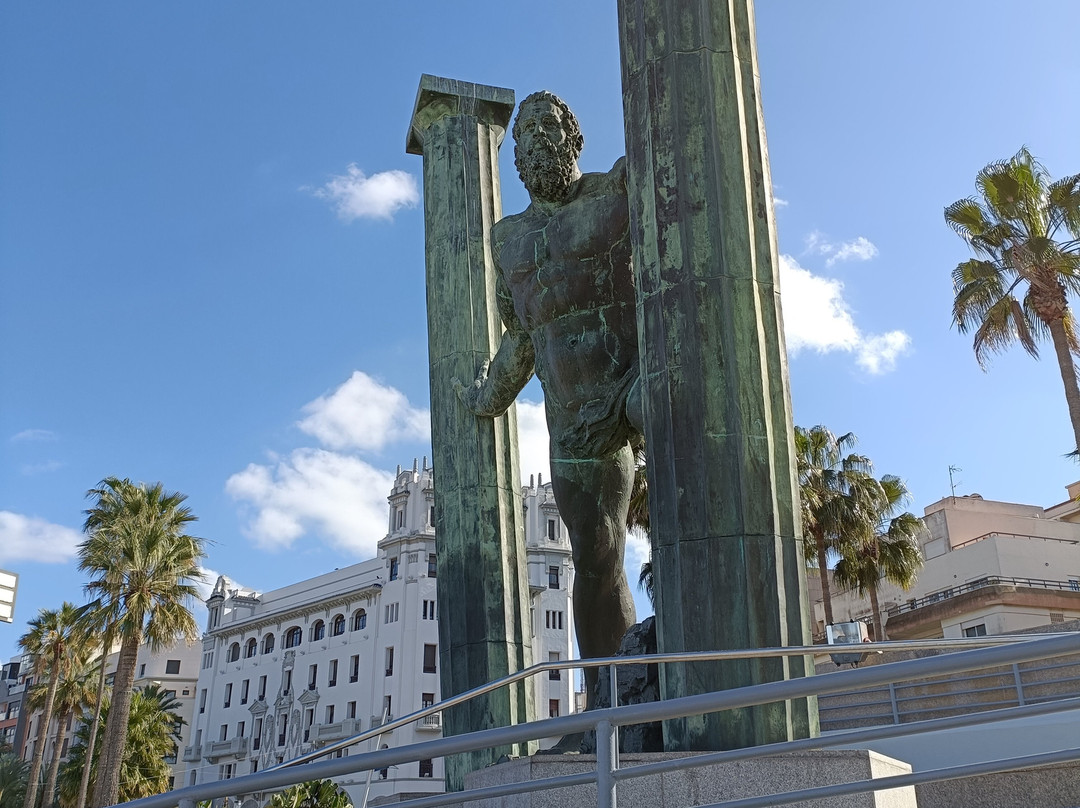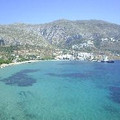的点评
Interesting history and mythology
Los Hercules y la Union del Mundo的点评
点评:This is a large sculpture showing Hercules pushing apart the pillars of Hercules.
The Pillars of Hercules were two promontories flanking the entrance to the Strait of Gibraltar, marking the boundary between the Mediterranean Sea and the Atlantic Ocean. In Greek mythology, these pillars were said to have been created by Hercules (known as Heracles in Greek) during his tenth labour. The northern pillar, called Calpe Mons, is identified as the Rock of Gibraltar in Europe. The southern pillar is either Monte Hacho (Abyla, in ancient times) now with a castle on the top of it, overlooking the city of Ceuta, or the taller mountain called Jebel Musa, located a little west in northern Morocco.
There are different myths on the origins. Some legends say that Hercules could have broken through a mountain to create the Strait of Gibraltar, forming the two pillars on either side of the Strait. Or he narrowed an existing strait to prevent monsters from the Atlantic Ocean from entering the Mediterranean Sea. Whatever, it is said that to the ancient Greeks and Romans they represented the demarcation between the known and unknown world.
The Pillars of Hercules were two promontories flanking the entrance to the Strait of Gibraltar, marking the boundary between the Mediterranean Sea and the Atlantic Ocean. In Greek mythology, these pillars were said to have been created by Hercules (known as Heracles in Greek) during his tenth labour. The northern pillar, called Calpe Mons, is identified as the Rock of Gibraltar in Europe. The southern pillar is either Monte Hacho (Abyla, in ancient times) now with a castle on the top of it, overlooking the city of Ceuta, or the taller mountain called Jebel Musa, located a little west in northern Morocco.
There are different myths on the origins. Some legends say that Hercules could have broken through a mountain to create the Strait of Gibraltar, forming the two pillars on either side of the Strait. Or he narrowed an existing strait to prevent monsters from the Atlantic Ocean from entering the Mediterranean Sea. Whatever, it is said that to the ancient Greeks and Romans they represented the demarcation between the known and unknown world.
翻译:这是一座大型雕塑,描绘了赫拉克勒斯推开赫拉克勒斯柱的情景。
赫拉克勒斯柱是直布罗陀海峡入口两侧的两座海角,标志着地中海和大西洋的边界。在希腊神话中,据说这些柱子是赫拉克勒斯(希腊语中称为赫拉克勒斯)在他的第十次劳动中创造的。北柱被称为卡尔佩蒙斯,在欧洲被称为直布罗陀巨岩。南柱要么是现在的蒙特哈乔(古代称为阿比拉),上面有一座城堡,俯瞰休达市,要么是位于摩洛哥北部稍西边的更高的山杰贝尔穆萨。
关于它的起源有不同的神话。一些传说说赫拉克勒斯可能打破了一座山,创造了直布罗陀海峡,形成了海峡两边的两根柱子。或者他缩小了现有的海峡,以防止大西洋的怪物进入地中海。无论如何,据说对古希腊人和古罗马人来说,它们代表了已知世界和未知世界的分界线。
赫拉克勒斯柱是直布罗陀海峡入口两侧的两座海角,标志着地中海和大西洋的边界。在希腊神话中,据说这些柱子是赫拉克勒斯(希腊语中称为赫拉克勒斯)在他的第十次劳动中创造的。北柱被称为卡尔佩蒙斯,在欧洲被称为直布罗陀巨岩。南柱要么是现在的蒙特哈乔(古代称为阿比拉),上面有一座城堡,俯瞰休达市,要么是位于摩洛哥北部稍西边的更高的山杰贝尔穆萨。
关于它的起源有不同的神话。一些传说说赫拉克勒斯可能打破了一座山,创造了直布罗陀海峡,形成了海峡两边的两根柱子。或者他缩小了现有的海峡,以防止大西洋的怪物进入地中海。无论如何,据说对古希腊人和古罗马人来说,它们代表了已知世界和未知世界的分界线。

此点评仅代表旅行者个人的主观意见,并不代表TripAdvisor以及其合作方的意见。
关于我们
|
新闻动态
|
商务合作
|
会员中心
|
业主中心
|
业主通
|
常见问题
|
意见反馈
|
联系我们
|
营业执照
© 2025 Tripadvisor 版权所有。
使用条款 |隐私政策 |网站工作原理
部分照片由 VFM Leonardo 提供。
* Tripadvisor不是旅行社,也不是旅游预订服务代理商。我们提供免费、客观、公正的旅游资讯服务。 (显示更多)
TripAdvisor LLC 既不是预订代理商,也不是旅游运营商,不会向网站用户收取任何服务费。 按照规定,在 Tripadvisor 发布机票价格、游览和旅行套餐的合作伙伴(航空公司、旅行提供商及预订代理商),其标价须包含所有费用和附加费用。 例如, 机场出入境税费、消费税与其他服务费、手续费、杂费及附加费用。 当您向我们的某个合作伙伴进行预订时,请务必查阅他们的网站以了解当地行政部门要求的所有适用费用的具体情况。 除非另有说明,机票价格通常指的是一个人的价格(以人民币计)。
为方便起见,TripAdvisor LLC 根据从我们的预订合作伙伴获取的空房率计算每个酒店的均价。 对于游览和景点来说,所显示价格通常是每位成人的最低可用价格。 对于列出的任何旅行套餐或优惠,TripAdvisor LLC 无法保证任何特定的费率或价格。 此外,酒店均价每晚会更新,并以您的首选币种表示(使用现行汇率)。 由于这些已换算的价格是预估价格,因此,有关具体金额和币种请与预订网站进行核实。
此外,TripAdvisor LLC 无法保证我们网站上宣传的价格随时有效。 标价可能需要预订一定天数才能生效,或有不可用日期、使用条件或限制。
TripAdvisor公司对外部网站的内容一概不负责。优惠价格中不含税和其他费用。
ICP证:沪B2-20200433
沪ICP备20013175号
 沪公网安备31010502005427号
沪公网安备31010502005427号鹰程信息技术(上海)有限公司
货币/国家及地区
¥CNY
中国

